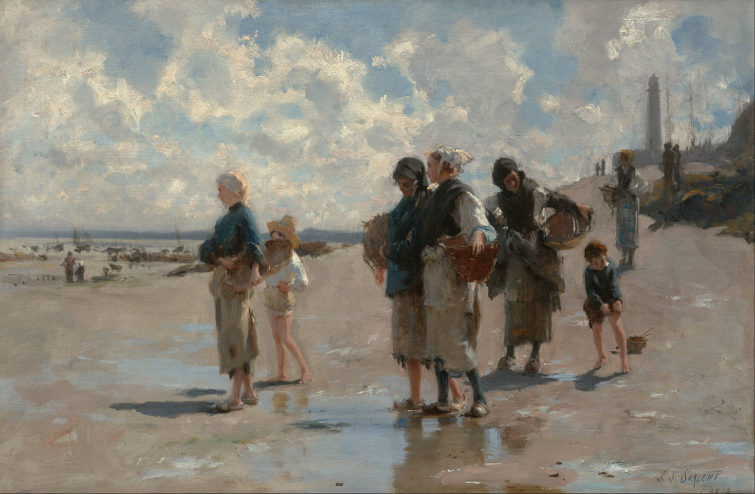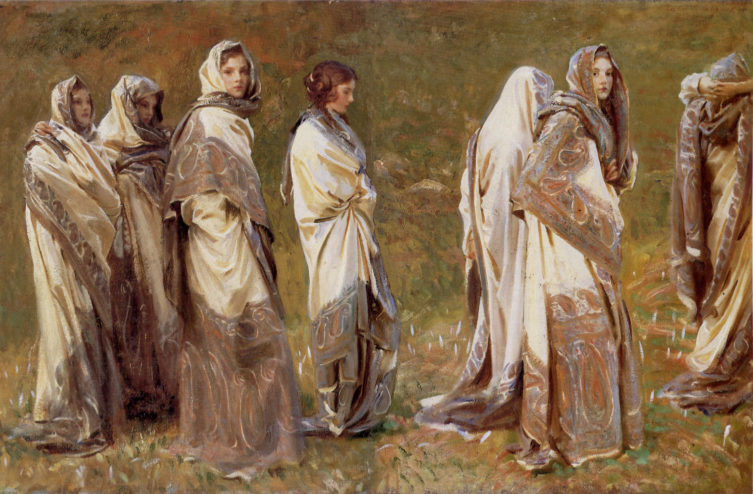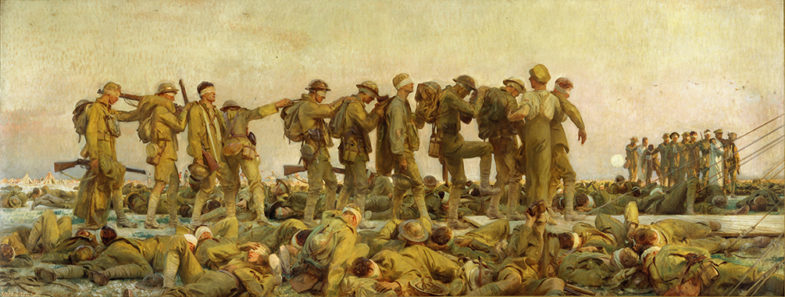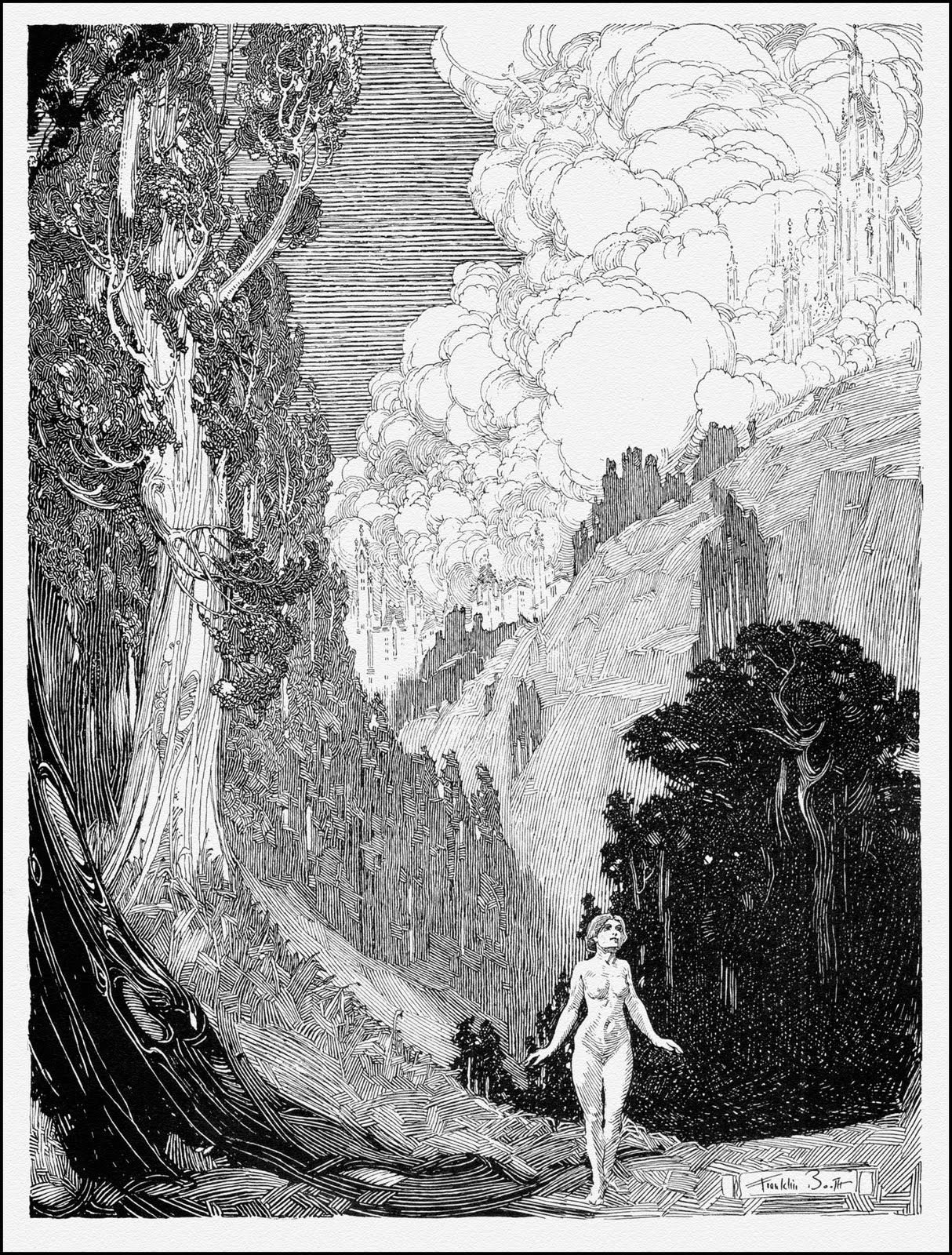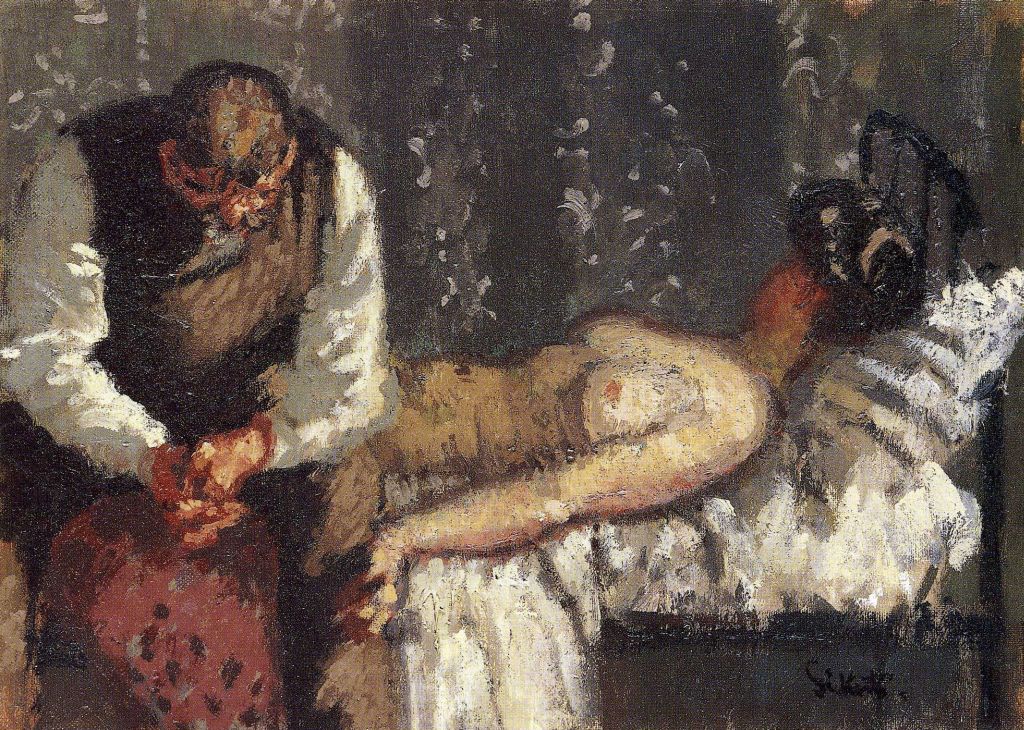As I was looking at John Singer Sargent’s work, in anticipation of writing today’s article about his wonderful “Cashmere” painting below, I started looking at many of his other works. Now, that’s not at all unusual, I find myself leaping down the rabbit hole when it comes to art most of the time, and looking at Sargent’s art definitely piques my interest.
As I was admiring his detailed, and yet impressionistic, strokes, I started to notice differences in how Sargent dealt with a procession of people. “Cashmere” has been a favorite of mine for a long time, but seeing his techniques and ideas evolve over time became more interesting than just another discussion of the cool art of the moment.
So, here we are, starting with…
Fishing for Oysters at Cancale (1878, large version here)
This is the earliest of the three pieces we’re looking at today. Despite Sargent’s muted tones, it’s clear that this is a nice, sunny day at the beach. It is possible that there might be some work to do, but it seems like a relaxing time near the water in spite of it.
There’s an open feeling to it, and Sargent used perspective and composition to really give that freedom to the piece. It is a procession with a general direction, but not a final one, and Sargent used his skills to make us feel at ease. These people are off to have a day at the beach, and frankly I’d like to go with them.
Cashmere (1908, large version here)
Thirty years later, Sargent captured his niece in different poses, leading to this procession. It’s been a favorite of mine for many reasons, certainly for composition and style. But overall what I like the most about it is the sense of mystery it has to it. For me, I think of it as a procession of sisters, or even mythological creatures like naiads or elves. I see them as being on their way to some event, and seemingly a concerning one. Sargent seems to have captured them in an unexpected moment, on the way to a serious problem ahead.
That’s where this piece differs from “Fishing for Oysters at Cancale,” a sense of some concerning event in the future. There’s not a sense of stress, per se, the women do not seem particularly concerned with current events. But I get the sense from their poses, their intent, and just the emotions given that they are on a path towards something that is a bit more serious than just a day at the beach.
The colors have shifted from the beach and the blue sky, but “Cashmere” and its earth tones are still muted. There’s more contrast, especially in the beautiful cashmere patterns, than the more muted “Fishing for Oysters at Cancale.” But the brushstrokes are tighter, less impressionistic, and combined with the earth tones give a more determined sense to the piece.
Gassed (1919, large version here)
The procession here, over a decade removed from “Cashmere,” is seemingly the tightest and most detailed of the three images. Where we started with a nice stroll on the beach, we end now on a different beach, and a completely different procession. These damaged men on their way out, if they can find it.
What is impossible to show in this little 600 pixel version is how massive this painting really is. It is over 20 feet wide, and while there are many details in it I encourage you to view the giant version below. Sargent still used broad strokes, and a somewhat loose brush, but because it is so large the detail is gained enormously when it shrinks for a web site.
It is clear though that Sargent made his image take a more serious tone by actually lightening up his palette. Compared with the other two, the inference is that this is an even brighter sunny day. Yet, he set the stage to be either daybreak or late in the day, with the sun low on the horizon. The soldiers stand not in muted tones within the sky and earth, but they contrast heavily as they break into the sky. It might be as sunny as “Fishing for Oysters at Cancale,” but there is no levity here.
See previous editions and subscribe to new articles here.
Where there’s no levity, the sense of determination seen in “Cashmere” remains apparent. But it feels different than the earlier piece. The women in “Cashmere” are clearly determined to go, and are heading in a strong direction. These men are headed somewhere, but their posing couldn’t be more different. They can’t see, they are injured, and they are relying on the leader in the front to get them somewhere safe. There’s a determination to see safety, but a tired sense of fate drags them into melancholy.
Sargent captured three interesting takes on processions, with different results despite similar painting methods. But in those 40 years he moved his characters from a happy beach, to a determined walk, and back to a beach. We ourselves have moved from the sense of relaxation, through determination, and ending with resignation and loss. It shows the strength of a truly great artist, one that can lead us emotionally simply through wonderful use of color, canvas, and a brush.
References
Cashmere
https://www.wikiart.org/en/john-singer-sargent/cashmere
https://en.wikipedia.org/wiki/Cashmere_(painting)
Fishing for Oysters at Cancale
http://www.mfa.org/collections/object/fishing-for-oysters-at-cancale-32503
Gassed
http://www.iwm.org.uk/collections/item/object/23722
